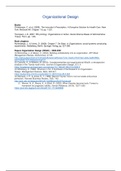Organizational Design
Books
Christensen, C. et al. (2009). The Innovator’s Prescription. A Disruptive Solution for Health Care. New
York: McGraw Hill. Chapter 1-6, pp. 1-221.
Thompson, J.D. (2007, fifth printing). Organizations in Action. Social Science Bases of Administrative
Theory. Part I, pp. 1-83.
Book chapters
Achterbergh, J., & Vriens, D. (2009). Chapter 7. De Sitter. In Organizations: social systems conducting
experiments. Heidelberg, Berlin: Springer Verlag, pp. 227-280.
Papers Organization Design (OD&D) – 2020-2021
(3) Birkinshaw, J. & Gibson, C. (2004). Building ambidexterity into an organization. MIT Sloan
Management Review, 45(Summer), 47-55.
http://web.b.ebscohost.com/ehost/pdfviewer/pdfviewer?vid=1&sid=27b415e2-e22a-4ad8-990e-
dde76a6d0742%40sessionmgr101
(5) Camuffo, A., & Wilhelm, M. (2016). Complementarities and organizational (Mis)fit: a retrospective
analysis of the Toyota recall crisis. Journal of Organization Design, 5(1), 4.
https://jorgdesign.springeropen.com/articles/10.1186/s41469-016-0006-6
(2) Mintzberg, H. (1980). Structure in 5's: A Synthesis of the Research on Organization
Design. Management Science, 26(3), 322-341.
https://pubsonline.informs.org/doi/abs/10.1287/mnsc.26.3.322
(4) Womack, J. P., & Jones, D. T. (1996). Beyond Toyota: how to root out waste and pursue
perfection. Harvard Business Review, 74(5), 140.
http://prof.usb.ve/nbaquero/06%20-%20Beyond%20Toyota.pdf
(1) Worren, N. A., Moore, K., & Elliott, R. (2002). When theories become tools: Toward a
framework for pragmatic validity. Human Relations, 55(10), 1227-1250.
https://journals.sagepub.com/doi/pdf/10.1177/a028082
,Index
Lecture 1. Introductory lecture ........................................................................................................ 3
→ Article 1: (1) Worren, N. A., Moore, K., & Elliott, R. (2002). When theories become tools:
Toward a framework for pragmatic validity. Human Relations, 55(10), 1227-1250. ................... 3
Lecture 2. Configurational approach............................................................................................... 5
→ Article 2 – 3: (2) Mintzberg, H. (1980). Structure in 5's: A Synthesis of the Research on
Organization Design. Management Science, 26(3), 322-341. .................................................... 5
(3) Birkinshaw, J. & Gibson, C. (2004). Building ambidexterity into an organization. MIT Sloan
Management Review, 45(Summer), 47-55. ................................................................................ 5
Lecture 3. Lean............................................................................................................................. 11
→ Articles 3 – 4: (4) Womack, J. P., & Jones, D. T. (1996). Beyond Toyota: how to root out
waste and pursue perfection. Harvard Business Review, 74(5), 140. ...................................... 11
(5) Camuffo, A., & Wilhelm, M. (2016). Complementarities and organizational (Mis)fit: a
retrospective analysis of the Toyota recall crisis. Journal of Organization Design, 5(1), 4. ...... 11
Lecture 4. Thompson .................................................................................................................... 14
→ Book Organizations in action part 1 ..................................................................................... 14
Lecture 5. Sociotechnical System Design: De Sitter and beyond ................................................. 18
→ Book Achterbergh & Vriens Chapter 7 ................................................................................. 18
Lecture 6. Orientation to practice – Guest lecture Lean ............................................................... 22
Lecture 7. Disruptive innovation in health care ............................................................................. 24
→ Book Christensen intro + Ch 1, 2 ......................................................................................... 24
Lecture 8. Chronic diseases: facilitated networks ......................................................................... 29
→ Book Christensen Ch 5, 6 .................................................................................................... 29
Lecture 9. Precision and intuitive medicine, implications for disrupting the healthcare sector ...... 33
→ Book Christensen et al. Ch 2, 3, 4........................................................................................ 33
Lecture 10. Design in practice: an application of STSD and Christensen ..................................... 37
2
,Lecture 1. Introductory lecture
→ Article 1: (1) Worren, N. A., Moore, K., & Elliott, R. (2002). When theories become tools: Toward a framework
for pragmatic validity. Human Relations, 55(10), 1227-1250.
Intervention cycle
Problem choice: Every function/person can think of things in the organization that can be improved.
Framework for assessing design approaches
Design approaches: analysis > plan part of the intervention cycle
Organizational structure = the network of executed tasks related to orders. Structures can be
different in all organizations. Networks comes into existence due to grouping and allocation of
activities into tasks that can be performed by capacities.
Example: Coffee shop, cup of coffee is the order. There are several activities, for example: taking
order > making coffee > serving coffee. Division of labour between employees.
Task = connection between employees. Tasks are connected, which makes a network for an order.
General requirements of organizational design approaches:
1. Relevant V’s = variable’s. Against the background of the goals/mission. Not about the content of
the organization, but what the organization wants to achieve.
2. Relevant P’s = parameter’s. You can break the organization down in different parts, these parts
can be seen as parameter’s. You need to be able to tune these different parts.
3. The causal/conceptual relationship between relevant P’s and V’s. How/why. There is not
always a causal relationship, so there also can be a conceptual relationship.
4. Have pragmatic validity.
The pragmatic validity of knowledge (theories/approaches) can be judged by the extent to which goals
or intended consequences (diagnoses/design) can be achieved by producing certain action or using
particular instruments (are approaches useful in practice?).
Focus on different ways in which knowledge (theory) can be represented.
Worren et al. focus on three representational modes:
- Propositional: prescriptive statements about potential managerial actions and outcomes. When A
happens, you have to do X. Downsides: not flexible, tunnel vision, sticking to bad practice.
(A1) Requirements: testability through explicit, causal propositions; Operational definitions of
constructs; Descriptions of how implementation is to proceed to achieve desired outcomes.
- Narrative: stories and anecdotes that illustrate a particular concept or suggest a course of action.
More ambiguous, very heavy on stories and anecdotes about a certain theory that is successful in
a situation. Example: Lean is connected with the success of Toyota. Downsides: different ways of
interpreting, less clear, less focus, what works for one organization doesn’t have to work for
another, more subjective.
(A1) Requirements: Vivid imaginary and persuasiveness; Ambiguity – flexibility in interpretation
and application; Plausibility through logical consistency in the ordering of the underlying plot.
- Visual mode: diagrams and other visual depictions of conceptual models. To what extent the
theory textually is represented by all kinds of diagrams and visual depictions of conceptual
models. This visuality can be useful for managers.
3
, (A1) Requirements: Appropriate symbolic and iconic representation of concepts and relationships;
Simplification or aggregation of complex information into meaningful patterns.
➔ Hard to have high scores on all three.
Individual theories/approaches can be represented in different ways, however, there may be dominant
modes, one of the three representational modes.
The usefulness of knowledge will depend on the degree of fit with such characteristics as the (1) type
of problem or decision being considered, (2) the phase in the process and (3) organizational
contextual factors.
4
, Lecture 2. Configurational approach
→ Article 2 – 3: (2) Mintzberg, H. (1980). Structure in 5's: A Synthesis of the Research on Organization
Design. Management Science, 26(3), 322-341.
(3) Birkinshaw, J. & Gibson, C. (2004). Building ambidexterity into an organization. MIT Sloan Management
Review, 45(Summer), 47-55.
The configurational approach is not a approach on its own. Within the configurational approach there
is a configuration from Mintzberg, Burns and Stalker, Miles and Snow. In this course we use the
configurational approach from Mintzberg.
Defining configurations
Configurations = constellations of conceptually distinct characteristics (elements) that commonly
occur together. Commonly is important here.
Related concepts that are more or less the same: types (Mintzberg), typologies (Miles et al.), gestalts
(Miller), forms (Short, Payne and Ketchen) → We take a holistic approach/view on organizations.
Internal fit / complementarity
Viable configurations and organizations in particular, can be seen as a bundle of choices and activities
(elements) that are highly interdependent and complement each other.
Complementarity: the value of X is increased by the presence of Y and vice versa.
Example: Marketing and R&D are important elements/departments in an organization. There is a high
level of complementarity between a marketing and a R&D department. Marketing people do research
in the field en see a ‘gat in de markt’ where the R&D department can look into. The value of the R&D
department is increased because we also have a marketing department. This is also the other way
around, when R&D people come up with ideas and the marketing department can find out if it works.
Internal fit = high level of complementarities between activities and choices in organizations.
Mintzberg: configuration hypothesis → limited diversity = important concept in the idea of
configurational approach.
(A2) The congruence hypothesis related organizational effectiveness to the fit between a given
design parameter and a given contingency factor. But a second hypothesis is also possible – what can
be called the configuration hypothesis – that effective structuring requires an internal consistency
among the design parameters. In fact, we can combine our two hypotheses to propose a third,
combined one, that we can call the extended configuration hypothesis: effective structuring
requires a consistency among the design parameters and the contingency factors.
Example: different elements (3) with different values (2: high or low). For configuring this organization,
you can have the different combinations (8) of elements and values, but we often don’t see this
number of combinations. Because, this idea of internal fit is not connected to all the combinations,
there is a misfit between some combinations. In theory you can have far more combinations than in
practice, because some combinations just don’t fit.
Example: low cost airlines, profit per ticket is higher. Very tight internal fit. Different categories
(Massa): resources (standardized fleet, one type of aircraft, non-union workers), management
decisions (cost-conscious, improve salary by additional stuff), operations (secondary airports, point-to-
point routing), services (no meals, no business class, nothing extra is free) and partners (low
commission travel agencies). All those categories are connected with each other, every connection is
a complementarity.
Example: FEI and Phenom is market leader in the production and distribution of complex electron
microscopes. They had a high internal fit. They wanted to use the technology of the electron
microscope to develop more simple products. Very complex to operate vs. easy to operate. They
failed to make this a success; they didn’t think about changes in complementarities. The internal fit
decreased.
5






